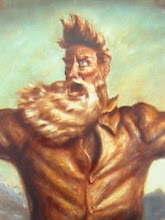Jennifer has it. The seventeen yr. old proved it just a few hours after graduating from a lifeguard academy. She was at the beach with a few friends when she saw another young lady caught in a rip-tide, going down for the count. Another person had attempted to rescue the stricken swimmer but realized that they were not going to be able to and had returned to the shore. Jennifer dove in and swam toward the victim, realizing that the rip current was going to prevent her from bringing the victim to the shore. Jennifer knew that if she could put the swimmer into a rescue position and get her head above water, they could wait it out until the lifeguards showed up with a boat. That's what Jennifer did. Did I mention that all of this went down in the dark?
Jessee has it. Jesse was on his way to work sometime after midnight when he came across a car that had just crashed into a cabinet shop. The car had gone into the structure so far that only the trunk was visible from outside. Jessee saw that the debris from the building and it's contents was preventing the occupants of the car from getting out through the doors and that the occupants were not able to kick out the rear window. Jessee also saw that the engine compartment of the car was on fire.as was some of the crash debris. Jessee proved that he had it when he jumped onto the car and kicked the rear window of the car, then assisting the occupants out of harms way.
Elaine has it. Elaine is a second grade teacher who was assigned to supervise the pick-up area after school. When she saw a SUV burning in the driveway, she approached it and noticed that there were two toddlers strapped into their car seats in the rear seat and the driver still behind the wheel, struggling with his seat belt. Elaine opened the rear door of the vigorously burning SUV and along with a parent, removed the toddlers from certain peril.
We all like to think that we have it. For those of us who are trained responders, our experience, training and education raise the threshold of where we begin to perceive risk. In other words, we may be in a situation where people watching believe us to be at risk, but as we have been there and done that, we don't feel the risk level is very high.
Most civilians do not have the luxury of the training experience and education that most of us responders have. Their actions are based on instinct, inner strength or a deep desire to help others despite personal risk. I think that is why I am so impressed with the stories above. They are the stories of those who have it, the ten percent or so who can be relied upon when the fecal material strikes the rotary ventilator.
Well done.
Thanks for reading,
Schmoe
Wednesday, October 24, 2012
Subscribe to:
Post Comments (Atom)


No comments:
Post a Comment